Is It Safe to Eat Turkey at 160 Degrees
You can safely eat turkey cooked to 160°F (71°C) if you follow proper resting procedures. While the USDA recommends 165°F for immediate consumption, removing the turkey at 160°F and allowing it to rest for at least 3.7 minutes achieves the same safety level. This is due to carryover cooking, where the internal temperature continues to rise after removal from the oven. Resting also improves moisture retention and flavor. It's vital to use an accurate digital thermometer, inserting it into the thickest parts of the turkey to guarantee proper temperature. By understanding the science behind turkey cooking, you'll master the art of preparing a safe, juicy bird.
This post may contain affiliate links. If you make a purchase through these links, I may earn a commission at no additional cost to you. Additionally, portions of this post may be generated using artificial intelligence (AI) technology. While we strive for accuracy, please be aware that AI-generated content may not always be perfect and should be fact-checked when necessary.
The Spatula Scoops
- Turkey can be safely removed from the oven at 160°F due to carryover cooking, which raises the temperature during resting.
- The USDA recommends a minimum internal temperature of 165°F for turkey to ensure safety.
- A resting period of at least 3.7 minutes at or above 150°F is necessary for pathogen reduction.
- Cooking turkey breast to 160°F and allowing it to rest can achieve the recommended 165°F while maintaining juiciness.
- Using a reliable digital instant-read thermometer is crucial for accurate temperature measurement and food safety.
USDA Temperature Guidelines
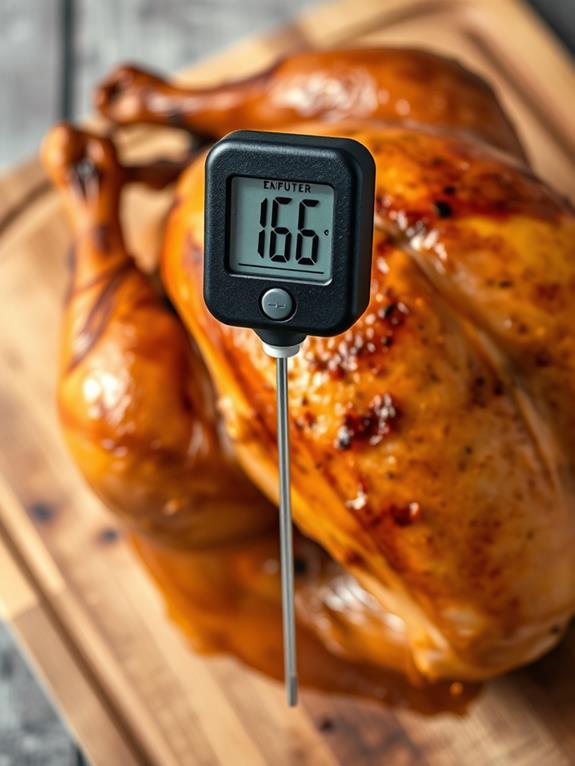
Temperatures play an essential role in guaranteeing your turkey is safe to eat. The USDA has established clear guidelines for food safety when it comes to cooking turkey. You'll want to aim for a minimum internal temperature of 165°F (74°C) in the thickest part of the breast and thigh. This temperature to cook is vital for eliminating harmful bacteria and achieving a 7.0 log reduction, which is the safety standard set by the USDA. It's significant to keep in mind that leaving cooked poultry at room temperature for extended periods can increase the risk of bacterial growth, similar to the risks associated with cooked chicken left out overnight food handling practices.
However, you can safely remove your turkey from the oven when it reaches 160°F (71°C). During the resting period, the temperature will continue to rise, reaching the recommended 165°F. It's essential to remember that for enhanced safety, your turkey should spend at least 3.7 minutes at or above 150°F (66°C). This time-temperature combination guarantees that any remaining bacteria are effectively eliminated.
When checking the temperature, always use a reliable meat thermometer and insert it into the thickest parts of the turkey. Don't rely on visual cues alone, as they can be misleading. By following these USDA temperature guidelines, you'll guarantee your turkey is both delicious and safe to eat.
The Science of Turkey Cooking
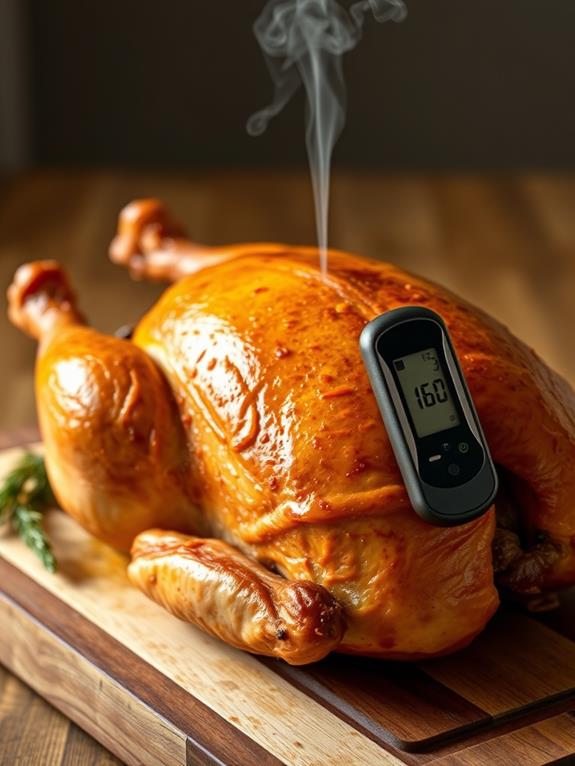
To understand why turkey can be safely eaten at 160°F, you need to explore the science behind cooking poultry. The internal temperature of your turkey is vital for safe cooking. While the USDA recommends 165°F, you can remove your bird from the oven at 160°F. This is because the temperature continues to rise during the resting period, often reaching the necessary 165°F. It is similar to the way you can prepare and store foods like cookie dough efficiently using durable silicone molds, which also undergo a change in state during freezing.
The key to safe turkey consumption lies in bacterial reduction. The USDA requires poultry to achieve a 7-log reduction of bacteria. This means that at lower temperatures, the meat must maintain that temperature for a specific duration. For example, turkey cooked at 150°F must hold that temperature for at least 3.7 minutes to be safe.
To make sure your turkey is cooked safely, follow these steps:
- Use a digital instant-read thermometer for precise measurements
- Check the temperature in multiple areas, especially the thigh joint
- Allow the turkey to rest after cooking
- Monitor the temperature during resting to confirm it reaches 165°F
Carryover Cooking Explained
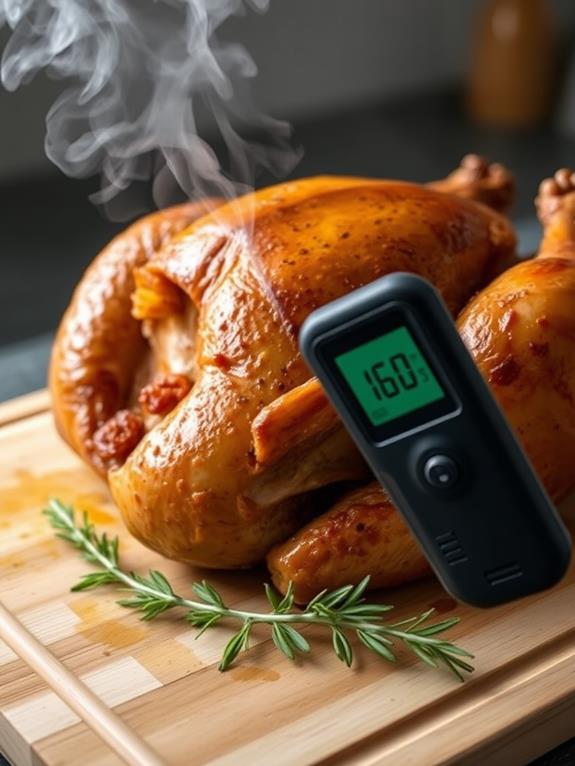
Carryover cooking is a significant concept to understand when preparing your Thanksgiving turkey. It's the phenomenon where your bird continues to cook even after you've removed it from the oven. This happens because of residual heat trapped inside the meat, which can cause the internal temperature to rise by about 5°F during the resting period. It's similar to how using a variety of rolling tools can help achieve perfect baking results through techniques that adapt to different dough types.
You might be wondering why this matters. Well, it's important for achieving the perfect balance between food safety and ideal doneness. For turkey, you can safely remove it from the oven when its internal temperature reaches 160°F. During the resting time, carryover cooking will bring the temperature up to the recommended safe minimum of 165°F.
Keep in mind that the duration of carryover cooking can vary depending on factors like the turkey's size and the cooking temperature. That's why it's critical to monitor the temperature closely. By understanding this process, you'll prevent overcooking and make certain your turkey is both safe to eat and deliciously tender. The resting period also allows juices to redistribute, enhancing the overall flavor of your Thanksgiving centerpiece.
Moisture Retention and Safety
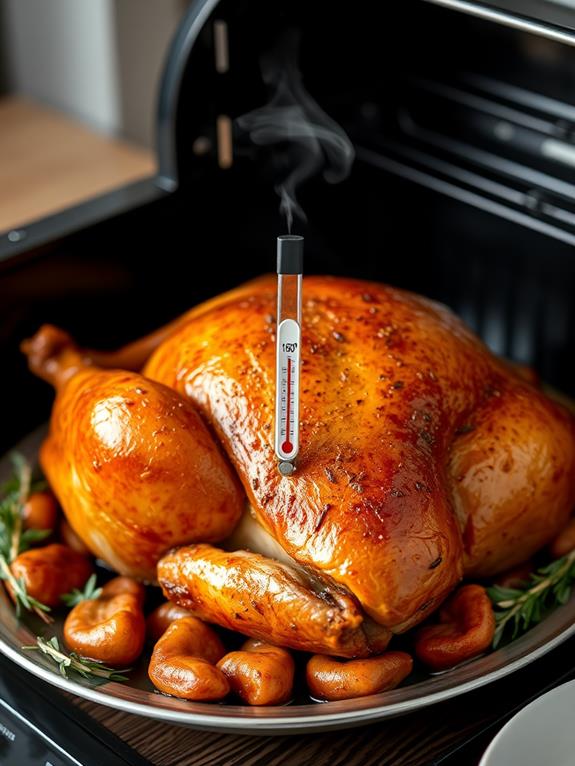
Balancing moisture retention and safety is vital when cooking turkey to 160°F. When you cook your turkey to this temperature, you're ensuring it's both moist and tender while also making it safe to eat. Here's why 160°F is an effective temperature:
- It allows for sufficient pathogen reduction
- It maintains better moisture retention compared to higher temperatures
- It provides a safety buffer during the resting period
- It allows for peak juiciness when combined with proper techniques. Versatile cooking options can also enhance your overall roasting experience.
At 160°F, your turkey will be ready to eat after a short resting period. This resting time is essential, as it allows the temperature to rise slightly, enhancing both safety and moisture retention. If you're aiming for an even juicier result, you can cook the turkey breast to 150°F and let it rest until it reaches 160°F.
To further improve moisture retention, consider brining your turkey before roasting. This technique can help the meat retain moisture even when cooked to the minimum safe temperature. By following these guidelines, you'll achieve a turkey that's not only safe to eat but also deliciously moist and tender.
Thermometer Accuracy and Usage

Accurate temperature measurement is key to guaranteeing your turkey is both safe and delicious at 160°F. To achieve thermometer accuracy, you'll need the right tools and techniques. The best thermometer for this job is a digital, instant-read model, like the ThermoPro TP-03B Instant Read Meat Thermometer, which provides quick, precise results in about 3-5 seconds, making it ideal for checking your turkey's doneness.
When using your thermometer, insert it into the thickest parts of the turkey's thigh and breast. Be careful not to touch bone, as this can lead to incorrect readings. Hold the thermometer steady until the temperature stabilizes for a reliable measurement. Remember, your turkey can be safely removed from heat at 160°F, as it'll continue to cook during resting, reaching the safe minimum of 165°F.
To maintain thermometer accuracy over time, regularly calibrate your device. This is especially important for digital models, which may drift in accuracy with use. By following these guidelines, you'll guarantee your thermometer provides trustworthy readings, helping you serve a perfectly cooked, safe turkey every time.
Alternative Cooking Methods
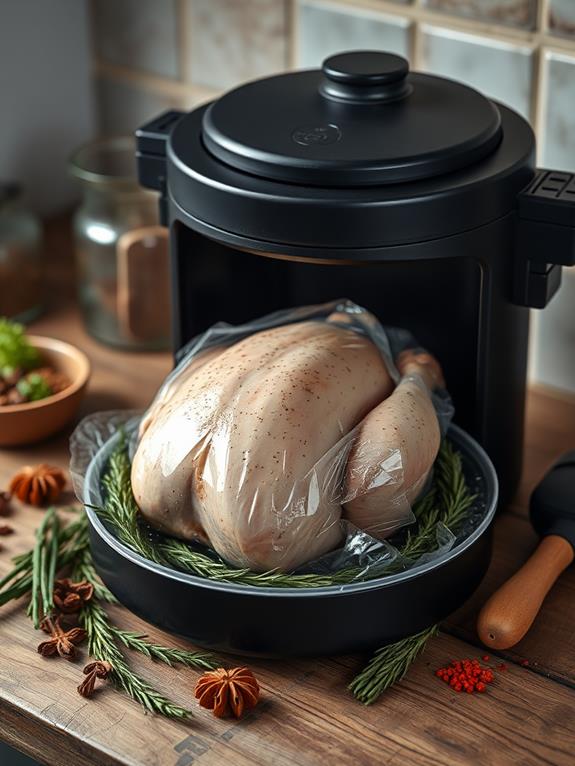
When exploring alternative cooking methods for turkey, you'll find sous vide preparation offers precise temperature control for tender results, ensuring that the meat is cooked evenly throughout. The Anova Culinary Sous Vide Precision Cooker 2.0 provides excellent temperature accuracy, making it a fantastic tool for achieving perfect turkey every time precise temperature control. If you're interested in adding smoky flavor, smoking techniques can infuse your bird with rich taste while still reaching the necessary internal temperature. For those seeking faster, more even cooking, spatchcocking (butterflying) your turkey can reduce cooking time and promote uniform doneness throughout the meat.
Sous Vide Turkey Preparation
For those seeking an alternative to traditional turkey preparation methods, sous vide cooking offers a precise and safe way to achieve a perfectly cooked bird at 160°F. When you cook your turkey sous vide, you'll seal it in a vacuum bag and submerge it in a temperature-controlled water bath. This technique guarantees even cooking and eliminates harmful bacteria while maintaining ideal texture.
To sous vide your turkey safely:
- Set your water bath to a consistent 160°F
- Cook the turkey for at least 2 hours
- Monitor the water temperature throughout the process
- Finish with a quick sear for crispy skin
Smoking Turkey Techniques
Another popular method for cooking turkey is smoking, which offers a unique flavor profile and tender results. When you smoke a turkey, you'll typically cook it at a lower temperature, between 225°F and 275°F. This slow cooking process allows the smoke to infuse the meat with flavor while keeping it moist.
Before you start smoking, consider brining your turkey. To brine a turkey, you'll soak it in a saltwater solution, often with added herbs and spices. This process helps the meat retain moisture during cooking and enhances its flavor. After brining, apply a dry rub to the skin for extra taste.
When you cook a turkey in a smoker, plan for about 30 to 40 minutes per pound at 225°F. It's essential to monitor the internal temperature, aiming for a minimum of 165°F for food safety. Use a meat thermometer to check the thickest part of the thigh and breast.
Choose your wood chips carefully, as different types impart various flavors. Hickory, apple, or cherry wood are popular choices for smoking turkey. Remember, smoking requires patience, but the result is a flavorful, tender bird that's worth the wait.
Spatchcocking for Even Cooking
Spatchcocking revolutionizes turkey cooking by promoting even heat distribution and reducing cooking time. This technique involves removing the backbone of your turkey, allowing it to lay flat during cooking. You'll find that spatchcocking offers several advantages over cooking a whole bird:
- Faster cooking times (25-30% reduction)
- More even heat distribution
- Juicier meat
- Crispier skin
When you spatchcock your turkey, you're creating a flatter surface area that exposes more of the bird to heat. This means you can cook it at a higher temperature, typically around 450°F, which results in that crispy skin you're after. The even heat distribution also means you'll reach safe internal temperatures more quickly and efficiently.
You'll have greater control over the internal temperature when spatchcocking. Even at 160°F, your turkey can reach peak doneness more efficiently than a whole bird. This method guarantees that your turkey cooks evenly, reducing the risk of dry breast meat or undercooked thighs. By using this technique, you're on your way to a perfectly cooked, juicy turkey in less time.
Expert Opinions on Turkey Doneness
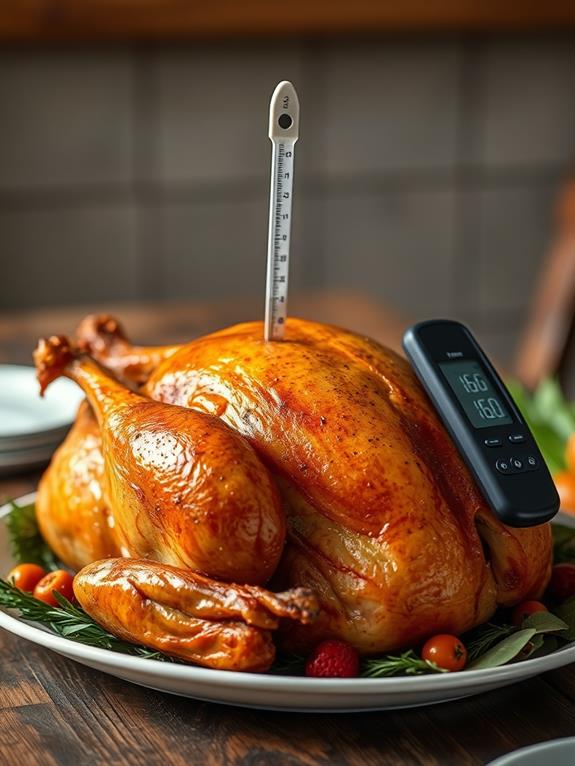
Culinary experts have weighed in on the topic of turkey doneness, and their opinions align with scientific findings. You'll find that many professionals advocate for cooking turkey breast to an internal temperature between 150°F and 160°F. This range guarantees a safe, yet juicy result, as it allows for proper cooking methods that minimize health risks. While the USDA recommends 165°F as a assured safe temperature, you can achieve the same food safety at 160°F if you maintain that temperature for at least 21 seconds.
When you're preparing your turkey, it's essential to use a digital instant-read thermometer for accurate temperature measurement. This tool will help you hit the sweet spot of 160°F, which allows for carryover cooking during the resting period. As your turkey rests, its internal temperature will continue to rise, reaching the USDA's recommended 165°F.
Frequently Asked Questions
Can You Eat a Turkey at 160 Degrees?
Yes, you can eat turkey at 160 degrees Fahrenheit. The USDA confirms that this temperature is safe when maintained for at least 26 seconds. It's significant to mention that the turkey's internal temperature will continue to rise during resting, often reaching 165 degrees. For ideal moisture and tenderness, many prefer cooking turkey breast to 160 degrees. Remember to check multiple areas, especially the thickest parts, to verify the entire turkey has reached this temperature. This approach guarantees both safety and quality.
Is 160 Good Enough for Turkey?
Yes, 160°F is good enough for turkey. You'll find that this temperature, though technically below the USDA's recommendation, is safe and savory. Here's why: carryover cooking continues after you've removed the bird from heat, raising the internal temperature to the safe 165°F. You'll need to use an instant-read thermometer to check the thickest parts, especially the thigh joint. Remember, maintaining 160°F for at least 3.7 minutes achieves a 7.0 log reduction of harmful bacteria, ensuring your turkey is both safe and succulent.
What Is the Lowest Safe Temp to Eat Turkey?
The lowest safe temperature to eat turkey depends on the part you're cooking. For turkey breast, you can safely remove it from the oven at 160°F (71°C), as it'll continue cooking to reach 165°F (74°C) while resting. However, for dark meat like thighs, aim for 170-175°F (77-79°C) for ideal doneness. Remember, it's not just about the final temperature; the meat needs to maintain a safe temperature long enough to kill harmful bacteria. Always use a reliable thermometer to check.
Is 160 Fine for Turkey?
Yes, 160°F is fine for turkey. When you cook your turkey to 160°F, it's safe to eat as long as it maintains that temperature for at least 3.7 minutes. During the resting period, carryover cooking will raise the temperature further, ensuring it reaches the USDA-recommended 165°F. This approach helps maintain moisture and tenderness. Remember to check the temperature in multiple spots, especially the thigh joint and breast. By removing the turkey at 160°F, you'll achieve both safety and a juicier texture.





